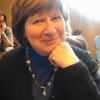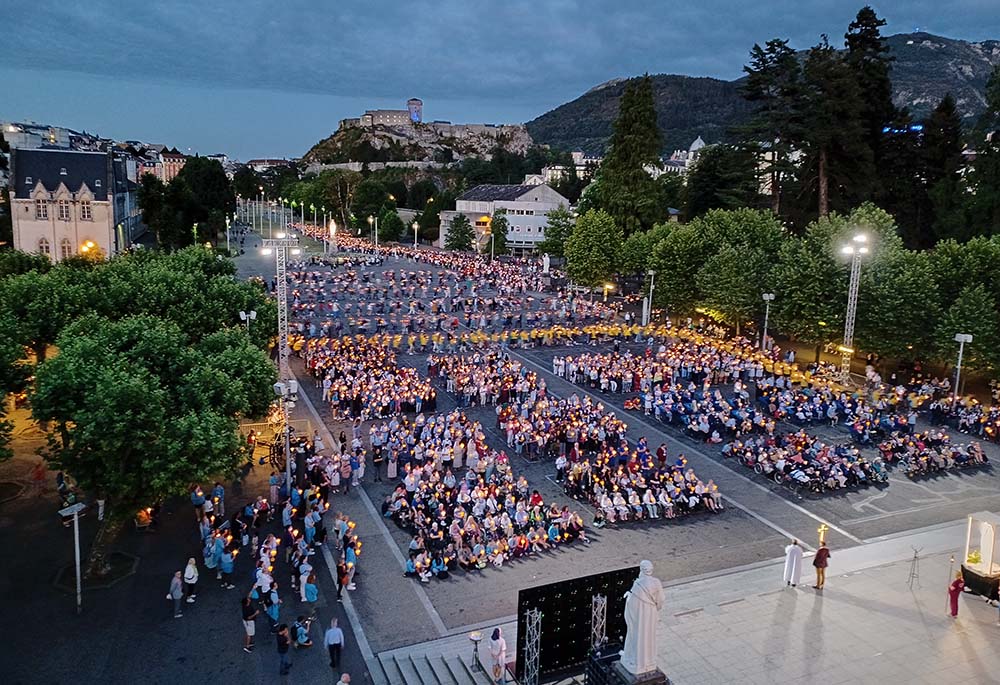
The night procession at 9 p.m. attracts thousands of visitors. It starts and ends in front of the Basilica of Our Lady of the Rosary in Lourdes, France. (GSR photo/Elisabeth Auvillain)
In the reading room of the "little convent," where guests can sit peacefully and families play board games with their children, Sr. Marie-Noël Suter recalls how the past two years have been so different.
"All of a sudden, our house, which we call "the little convent" where pilgrims are welcome, was empty," remembers Sr. Marie-Noël, superior of the community of the Sisters of the Immaculate Conception of Our Lady of Lourdes.
"Our mission here is to offer shelter to people who come to the sanctuary of Lourdes."
Like the rest of France, Lourdes was severely hit by the first confinement of March 2020 when nonessential buildings and services, including churches, were closed for two months in the hope to contain the COVID-19 pandemic. "During COVID, we could not go to Mass; we watched it on television, like everybody else in France," Sister Marie-Noël recalls.
France's public television transmits Mass every Sunday at 11 a.m. and its audience reached new heights during the confinements. Before COVID-19, up to 50 Masses were celebrated every day in one of the 30 churches or chapels of the Lourdes sanctuary, located half a mile away from the Le Petit Couvent. Only one other sister, Carmen, currently lives in the little convent with Sister Marie-Noël.
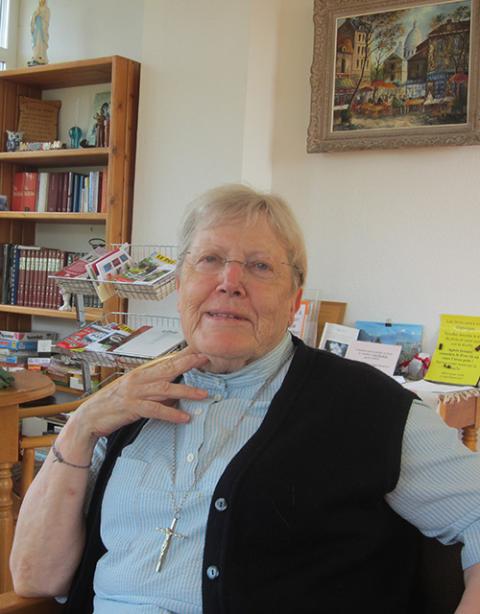
Sister Marie-Noël, superior of the community of the Sisters of the Immaculate Conception of Our Lady of Lourdes (GSR photo/Elisabeth Auvillain)
"We are here to welcome anyone who comes to Lourdes, to talk to them about hope. We are not a hotel, we spend time with our guests, we listen to them. We could not do this anymore for the past two years," Sister Marie-Noël said regretfully.
Pilgrims have been coming to Lourdes regularly since a young peasant girl, Bernadette Soubirous, went to see the local priest to tell him that a lady dressed in white appeared to her in a grotto in 1858. The lady told her that she was the Immaculate Conception. Bernadette did not have a clue what this meant, and she asked the priest. When he replied sharply, "Do you really want me to believe you?", her simple answer was: "I have been told to tell you, not to convince you."
Her word was then taken seriously by the priest, according to an official document published by the sanctuary.
Mary is said to have appeared 18 times to Bernadette, over a six-month period. The dogma of the Immaculate Conception, which means that Mary, Mother of God, never committed any sin, had been adopted by Rome in 1854, four years before.
During one of the apparitions, Bernadette began digging until water appeared, which then became a pool and a sacred spring. Bernadette — today, St. Bernadette — was instructed to tell the local priest to build a chapel in the grotto for visitors.
Among most visited
Since the apparitions, pilgrims have come in droves to Lourdes to seek help from Mary and pray to her at the grotto. It is among the most visited sites in the Christian world, with an estimated 4-6 million visitors a year before the pandemic, with more than 200 million said to have visited the shrine since 1860.
In Bernadette's time, the only community of women religious in Lourdes were the Sisters of Charity of Nevers, who ran the hospital, taking care of the sick and the elderly.
The Sisters of the Immaculate Conception came to Lourdes in 1870. Their community was founded earlier by Marie-Eugénie Ducombs, Elise Abadie and Jeanne-Marie Mandret. They first settled in 1863 in a house belonging to a priest in Lannemezan, a nearby village. As more and more pilgrims came to Lourdes after hearing about the apparitions, it made sense for the growing community to move there.
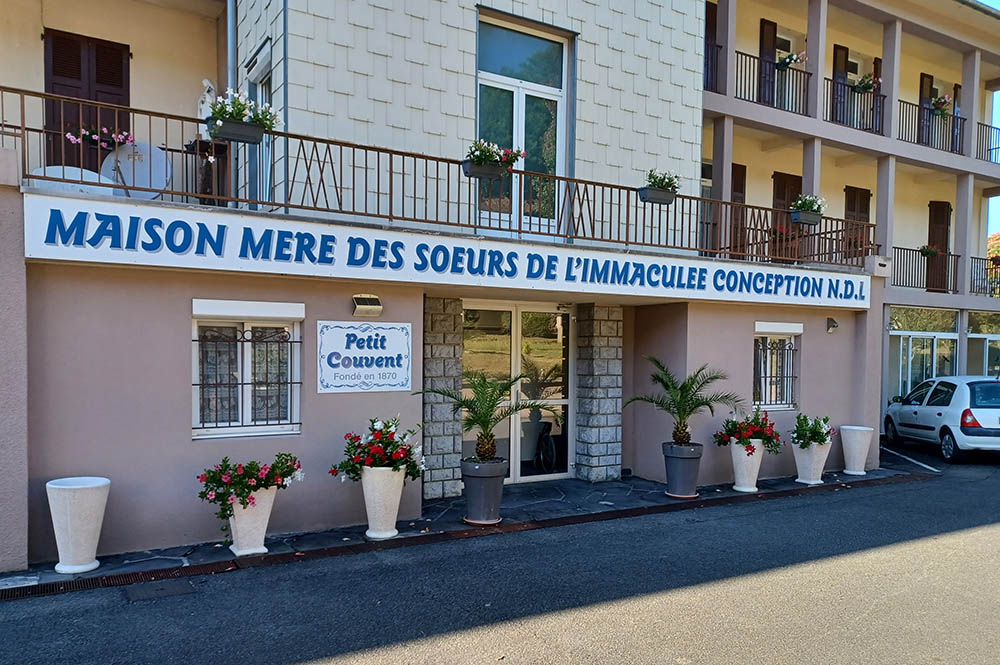
The Sisters of the Immaculate Conception of Our Lady of Lourdes welcome pilgrims to Le Petit Couvent, which has 40 bedrooms, including some large enough for families. During the past two years, visitors to Lourdes, France, dwindled because of the pandemic. The house was empty for two six-month periods during the past two years. (GSR photo/Elisabeth Auvillain)
The congregation has remained true to its vocation to welcome pilgrims and anyone searching for a time of reflection in a spiritual environment, as a "sign of life and hope, by bearing witness of the love of God, our Savior" as their constitution states.
The comfortable house where the sisters welcome pilgrims was redone before the pandemic. It has 40 bedrooms, including some where a family of four can stay, and two dormitories for young people. Pilgrims come between March and October, since winter months are very cold in this town close to the Pyrénées mountains. The house was empty of guests twice for six months in the past two years, Sister Marie-Noël told GSR.
"We ask people to stay a minimum of three nights. Some stay longer, sometimes up to two weeks. Coming from the outside world full of noise, we think some time is necessary to find peace and quiet and welcome grace," she explained.
In 2019, the last year before the pandemic, 3.5 million pilgrims came to Lourdes. In 2020, when two confinements were enforced in the spring and the fall, only 800,000 people visited the sanctuary, David Torchala, from the press office of the sanctuary, told GSR. Apart from the two confinement periods, people could travel within France and within Europe, with different regulations depending on the country.
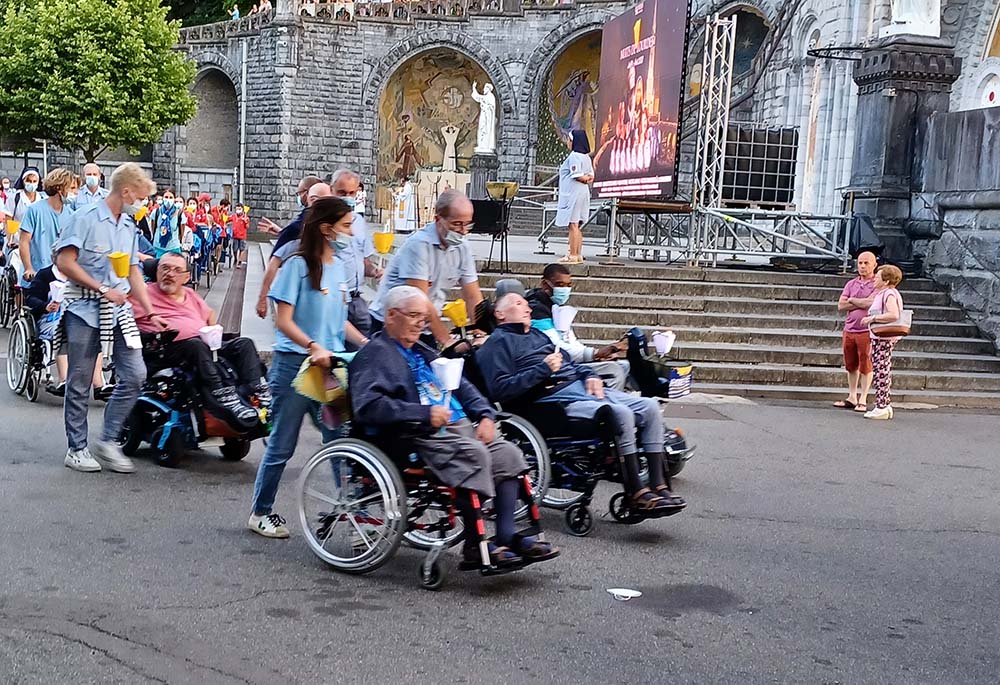
Sick, wounded or disabled people are given priority everywhere at the sanctuary in Lourdes, France: They are placed in the front of the crowd during celebrations and processions. (GSR photo/Elisabeth Auvillain)
Since then, the number has slowly increased: 1.5 million pilgrims in 2021. Lourdes hopes to see 1.6 million visitors in 2022, according to the sanctuary's press office. Before the pandemic, about 40% of visitors of were from France. Most French dioceses organize a yearly pilgrimage to Lourdes for sick and handicapped people.
Pilgrims from elsewhere are mostly from European countries. Walking on the huge grounds of the sanctuary, one can hear many languages: French, Spanish — the border is only one hour away — Italian, English, German and Dutch. Tamil people, who originally came from the southern Indian province of Tamil Nadu and live in Britain or France, are also well represented. Not all visitors are Catholics: Hindus consider the Virgin Mary as one of their goddesses and pray to her.
In addition to the Sisters of the Immaculate Conception of Our Lady of Lourdes, about 30 other communities of women religious are in Lourdes. They welcome the pilgrims, offer housing, spiritual guidance, and care for the sick and disabled. Some, like the Carmelites and the Dominicans, live a life of prayer and do not leave their convents, even though it is located a short distance from the sanctuary. Franciscan sisters are in charge of the sacristy of the grotto.
The strict two-month confinement imposed in France in March 2020 came very suddenly. Nobody could venture further than 1 kilometer (0.6 mile) from their home. It meant the end of pilgrimages, which start in spring every year and last until the fall. The sanctuary was closed.
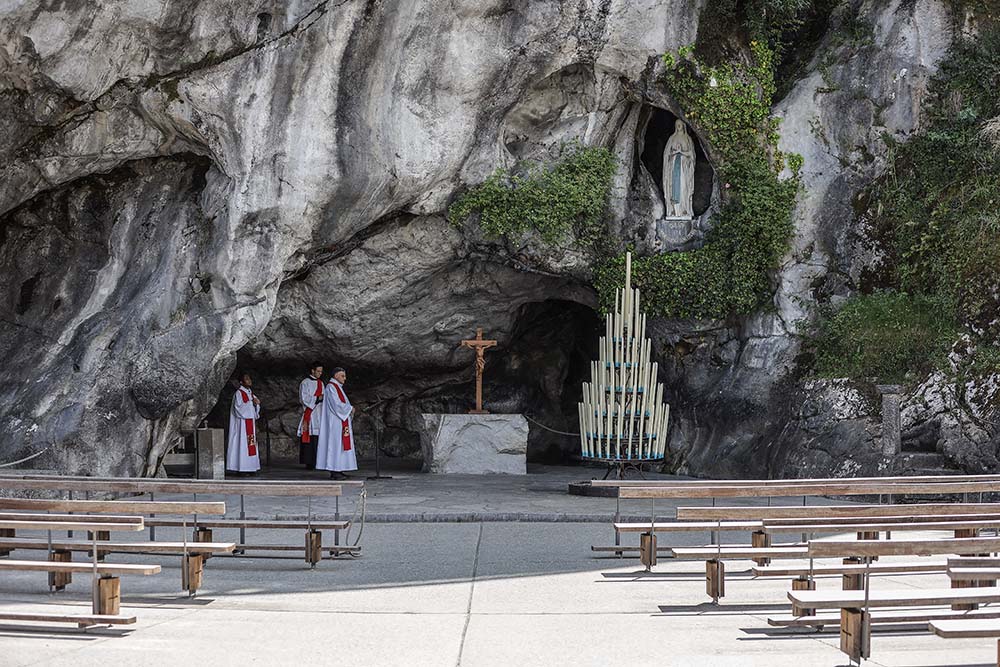
Empty pews are seen at the Shrine of Our Lady of Lourdes in France in early April 2020 during the COVID-19 pandemic. (CNS/JMP/ABACAPRESS.COM via Reuters/Thibaud Moritz)
There was another five-week-long confinement in October 2020. People could not venture further then 10 km (6 miles) from their home.
"COVID was a very significant event and unforeseen. We had to rethink our presence here," Don Jean-Xavier Salefran, a priest from the Community of St. Martin and vice-rector of the sanctuary, told Global Sisters Report. "During the confinement, we were the only ones to have access to the sanctuary, getting there through an underground path from our house, where all the chaplains live," he explained.
About 30 chaplains from different communities and different countries serve at Lourdes. Altogether, they speak about 10 languages, including French, Spanish, Italian and English, but also Vietnamese, Tamil, Romanian, Polish and Portuguese.
Bringing Lourdes to others
They decided use the internet to extend the reach of the shrine. "We organized continuous prayer at the grotto," Salefran said. "We started to broadcast live all the services, round the clock, on our channel. People could pray with us from anywhere in the world. We created a very strong link with pilgrims around the world. This gave a new, more international dimension to Lourdes. We spent a lot of time on the telephone, since people kept calling us."
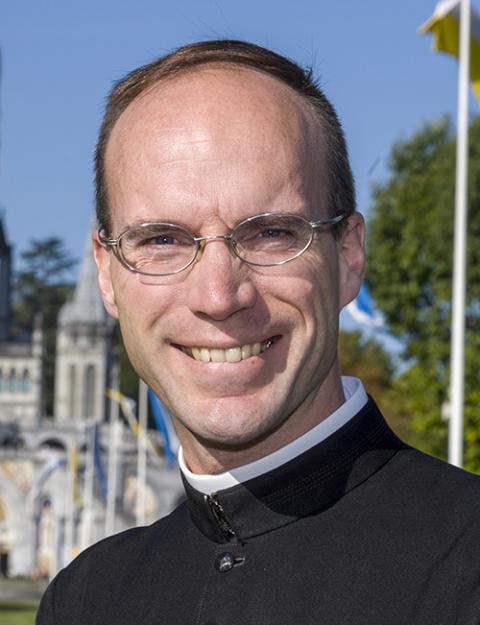
Don Jean-Xavier Salefran, a priest from the Commmunity of St. Martin and vice-rector of the Lourdes sanctuary (Courtesy of Sanctuaire Notre-Dame de Lourdes)
As the pandemic lasted, Salefran explained, "we thought: If people cannot come to Lourdes, let's go and see them. As soon as we could travel again, we went to visit dioceses."
In every French diocese, but also in Spain, Italy and England, there is a representative of Hospitality of Lourdes, the association that organizes the pilgrimages, Salefran explained. "We offered to go and see them, to talk about the sanctuary. We had very interesting meetings with many people, including schoolchildren and teenagers," he said.
"We are now more opened to the rest of the world. Bernadette's relics, for example, are now in the U.S., on a tour from east to west. Our bishop will go there soon to come back with them."
"We are now hoping to see millions of pilgrims, like before the pandemic. During the COVID years, people came individually. It is nice to see groups coming again."
According to Salefran, pilgrims have changed over the years: People who come to Lourdes are not only churchgoing Catholics. "They often do not know much about our celebrations," he said. "We had to explain the rituals, the gestures, even the celebration of the Eucharist."
Some sick pilgrims go to Lourdes hoping for a miracle, but these are not so frequent and only recognized after a long procedure involving medical doctors and serious consideration of the condition of the formerly sick person. Sick people often say they have been cured from a disease after visiting the shrine. There have been 70 declared miracles.
At a time when mental illnesses seem to become more and more common, "the pattern of pilgrimages as we know them today has to evolve," Msgr. Olivier Ribadeau Dumas, then-rector of the sanctuary, told the news organization La Croix in an interview in May. "How should we be welcoming to people with mental illnesses? How can we welcome people who are most vulnerable?" he asked, echoing worries made in private by regular visitors to Lourdes, clergy and laypeople.
Advertisement
Sick, wounded or disabled people are given priority everywhere: They are placed in the front of the crowd during celebrations and processions. For some, a trip to Lourdes is the only time spent away from the special homes they often have to live in because of their disability.
The gesture of the water
There are actually two churches, on top of each other, dominating the valley of the river that flows through Lourdes. Every night, a procession is held at 9 p.m., starting in front of the Basilica of Our Lady of the Rosary. Pilgrims hold torches and sing hymns to Mary. At night, this is spectacular. There are always several thousand people, sometimes many more, to take part in the long walk that starts and ends in front of the basilica. Hymns are sung in Latin, a language common to Roman Catholics all over the world, along the way.
The grotto is at the level of the river, on the side of the basilica, near the spring where the water of Lourdes flows. Next to the grotto is where pilgrims could immerse in water to be purified. The pandemic put an end to this ceremony, which is now simply named "the gesture of the water": Pilgrims pray, wash their hands and face and finally drink some of the water.
"Mary told Bernadette that people should come and wash with the water from the spring, then drink it. We only reproduce her demand. At some point, we'll probably offer total immersion in the pools like we did before, without giving up the gesture of the water," Salefran said. Pilgrims could then choose to take part in either one of the ceremonies."
The atmosphere in Lourdes is one of peaceful piety, where everyone is welcome. Like elsewhere in France, about three quarters of the people who take part in the celebrations, Masses, processions and other religious ceremonies such as the Way of the Cross are women. All of the ceremonies, not only the Eucharist, are led by priests. Even nuns, so present in Lourdes, do not play a visible role in the ceremonies.
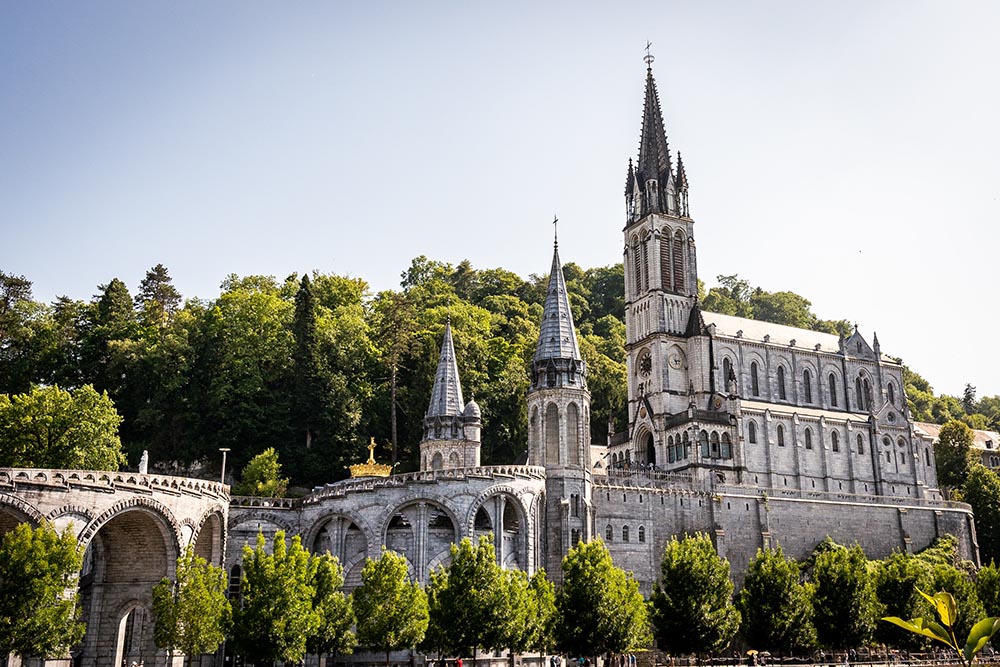
Lourdes is one of the most visited pilgrimage sites in the world. In 2019, the last year before the pandemic, 3.5 million pilgrims came to Lourdes, France. In 2020, only 800,000 people visited the sanctuary, Since then, the number has slowly increased: 1.5 million pilgrims in 2021. (Unsplash/Nick Castelli)
The rector runs the sanctuary of Lourdes with a close group of fewer than 10 people, which includes laypeople. Some time ago, a nun was a member of this group. Right now, none belong to it. "Sure, it would be nice if a sister was part of this group," Sister Marie Noël admits.
The rector who in charge of the sanctuary during the pandemic, Ribadeau Dumas, has left Lourdes after his three-year mission. His successor, Fr. Michel Daubanes, took office on Sept.1.
The rector has to deal with civil authorities, which became even more important during the pandemic. Lourdes is a small town of 13,000 inhabitants and 4,500 of them live off the sanctuary in some fashion: hoteliers, restaurants and shopkeepers, where souvenirs like rosaries are sold at low prices. All have seen their business drop sharply.
The sanctuary itself employs 320 people, who also had to be let go during parts of the pandemic and got unemployment benefits.
Government assistance, as in elsewhere in France, helped those who lost their jobs or had to close their shops during the confinements.
The future of Lourdes was considered important enough by French President Emmanuel Macron, who spent childhood summers in the region, to pay a short visit to the sanctuary on July 16. He confirmed the implementation of an economic plan, "Avenir Lourdes" ("Future Lourdes"), providing financial help to further develop the town and the region, severely hit by COVID-19. Believers and nonbelievers alike hope to see more pilgrims return soon.
